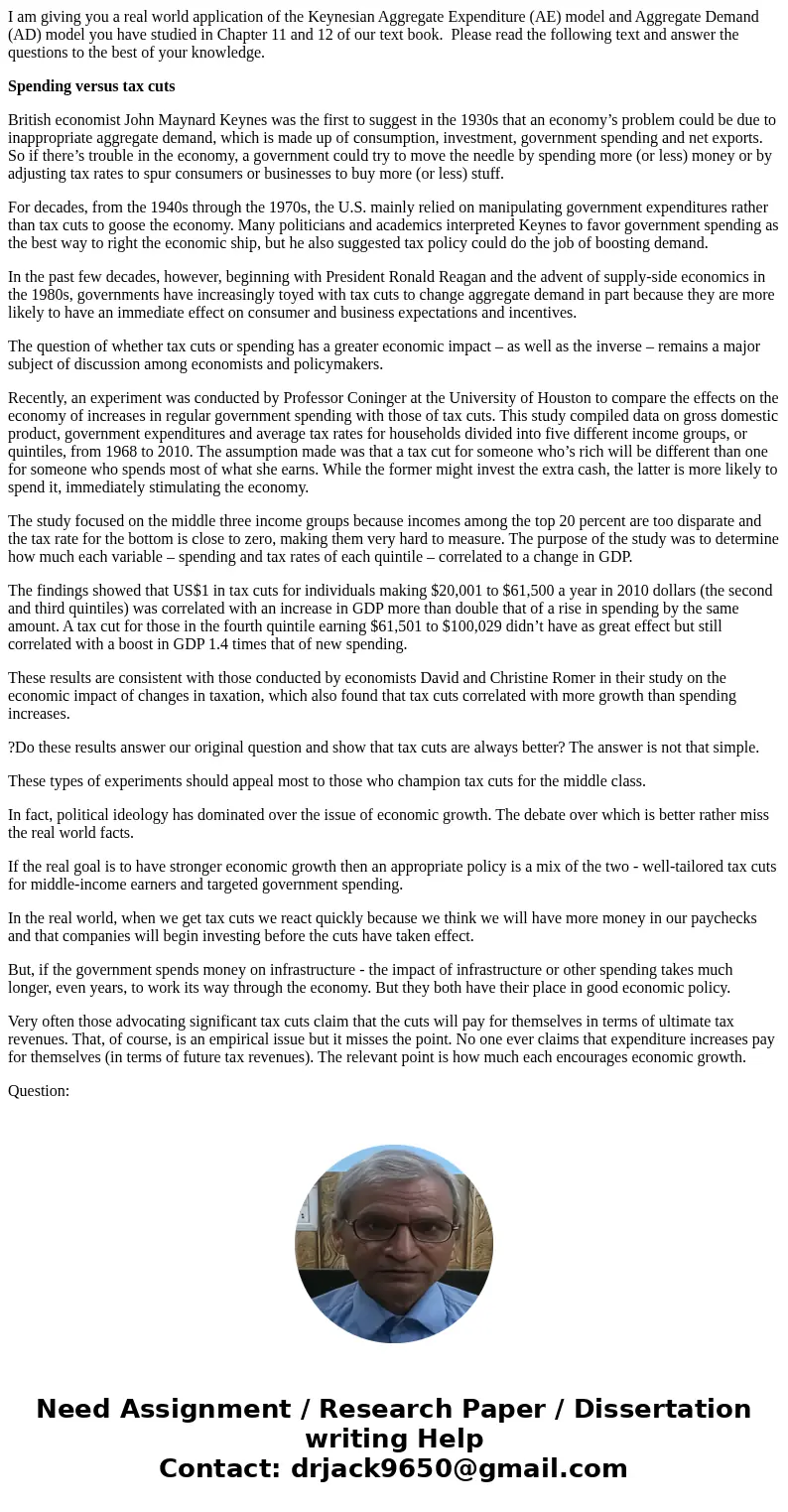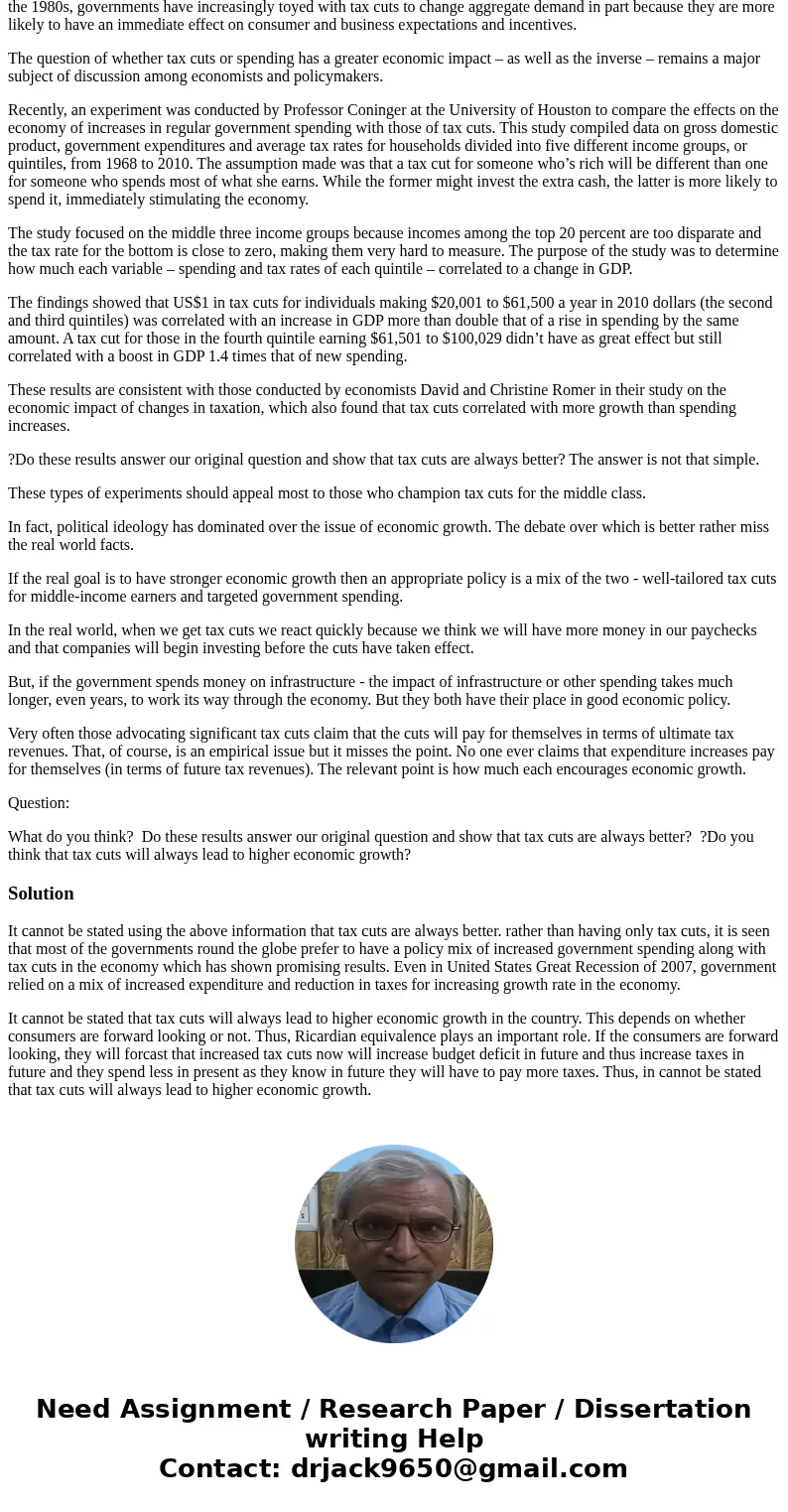I am giving you a real world application of the Keynesian Ag
I am giving you a real world application of the Keynesian Aggregate Expenditure (AE) model and Aggregate Demand (AD) model you have studied in Chapter 11 and 12 of our text book. Please read the following text and answer the questions to the best of your knowledge.
Spending versus tax cuts
British economist John Maynard Keynes was the first to suggest in the 1930s that an economy’s problem could be due to inappropriate aggregate demand, which is made up of consumption, investment, government spending and net exports. So if there’s trouble in the economy, a government could try to move the needle by spending more (or less) money or by adjusting tax rates to spur consumers or businesses to buy more (or less) stuff.
For decades, from the 1940s through the 1970s, the U.S. mainly relied on manipulating government expenditures rather than tax cuts to goose the economy. Many politicians and academics interpreted Keynes to favor government spending as the best way to right the economic ship, but he also suggested tax policy could do the job of boosting demand.
In the past few decades, however, beginning with President Ronald Reagan and the advent of supply-side economics in the 1980s, governments have increasingly toyed with tax cuts to change aggregate demand in part because they are more likely to have an immediate effect on consumer and business expectations and incentives.
The question of whether tax cuts or spending has a greater economic impact – as well as the inverse – remains a major subject of discussion among economists and policymakers.
Recently, an experiment was conducted by Professor Coninger at the University of Houston to compare the effects on the economy of increases in regular government spending with those of tax cuts. This study compiled data on gross domestic product, government expenditures and average tax rates for households divided into five different income groups, or quintiles, from 1968 to 2010. The assumption made was that a tax cut for someone who’s rich will be different than one for someone who spends most of what she earns. While the former might invest the extra cash, the latter is more likely to spend it, immediately stimulating the economy.
The study focused on the middle three income groups because incomes among the top 20 percent are too disparate and the tax rate for the bottom is close to zero, making them very hard to measure. The purpose of the study was to determine how much each variable – spending and tax rates of each quintile – correlated to a change in GDP.
The findings showed that US$1 in tax cuts for individuals making $20,001 to $61,500 a year in 2010 dollars (the second and third quintiles) was correlated with an increase in GDP more than double that of a rise in spending by the same amount. A tax cut for those in the fourth quintile earning $61,501 to $100,029 didn’t have as great effect but still correlated with a boost in GDP 1.4 times that of new spending.
These results are consistent with those conducted by economists David and Christine Romer in their study on the economic impact of changes in taxation, which also found that tax cuts correlated with more growth than spending increases.
?Do these results answer our original question and show that tax cuts are always better? The answer is not that simple.
These types of experiments should appeal most to those who champion tax cuts for the middle class.
In fact, political ideology has dominated over the issue of economic growth. The debate over which is better rather miss the real world facts.
If the real goal is to have stronger economic growth then an appropriate policy is a mix of the two - well-tailored tax cuts for middle-income earners and targeted government spending.
In the real world, when we get tax cuts we react quickly because we think we will have more money in our paychecks and that companies will begin investing before the cuts have taken effect.
But, if the government spends money on infrastructure - the impact of infrastructure or other spending takes much longer, even years, to work its way through the economy. But they both have their place in good economic policy.
Very often those advocating significant tax cuts claim that the cuts will pay for themselves in terms of ultimate tax revenues. That, of course, is an empirical issue but it misses the point. No one ever claims that expenditure increases pay for themselves (in terms of future tax revenues). The relevant point is how much each encourages economic growth.
Question:
What do you think? Do these results answer our original question and show that tax cuts are always better? ?Do you think that tax cuts will always lead to higher economic growth?
Solution
It cannot be stated using the above information that tax cuts are always better. rather than having only tax cuts, it is seen that most of the governments round the globe prefer to have a policy mix of increased government spending along with tax cuts in the economy which has shown promising results. Even in United States Great Recession of 2007, government relied on a mix of increased expenditure and reduction in taxes for increasing growth rate in the economy.
It cannot be stated that tax cuts will always lead to higher economic growth in the country. This depends on whether consumers are forward looking or not. Thus, Ricardian equivalence plays an important role. If the consumers are forward looking, they will forcast that increased tax cuts now will increase budget deficit in future and thus increase taxes in future and they spend less in present as they know in future they will have to pay more taxes. Thus, in cannot be stated that tax cuts will always lead to higher economic growth.


 Homework Sourse
Homework Sourse